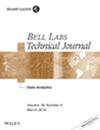下载PDF
{"title":"Probabilistic Radio-Frequency Fingerprinting and Localization on the Run","authors":"Piotr Mirowski, Dimitrios Milioris, Philip Whiting, Tin Kam Ho","doi":"10.1002/bltj.21649","DOIUrl":null,"url":null,"abstract":"<p>Indoor localization is a key enabler for pervasive computing and network optimization. Wireless local area network (WLAN) positioning systems typically rely on fingerprints of received signal strength (RSS) measures from access points. In this paper, we review approaches for modeling full distributions of Wi-Fi signals, including Bayesian graphical models, smoothing, compressive sensing, and random field differentiation and concentrate on the Kullback-Leibler divergence metric that compares multivariate RSS distributions. We provide theoretical insights on the required spatial density of fingerprints and on the number of samples necessary, during tracking or during signal map building, to differentiate among signal distributions and to provide accurate location estimates. We validate our methods on contrasting datasets where we obtain state-of-the-art localization results. Finally, we exploit datasets collected by a self-localizing mobile robot that continuously records Wi-Fi along with ground truth position, where we define increasingly denser fingerprint grids and study asymptotic localization accuracy. © 2014 Alcatel-Lucent.</p>","PeriodicalId":55592,"journal":{"name":"Bell Labs Technical Journal","volume":"18 4","pages":"111-133"},"PeriodicalIF":0.0000,"publicationDate":"2014-02-26","publicationTypes":"Journal Article","fieldsOfStudy":null,"isOpenAccess":false,"openAccessPdf":"https://sci-hub-pdf.com/10.1002/bltj.21649","citationCount":"58","resultStr":null,"platform":"Semanticscholar","paperid":null,"PeriodicalName":"Bell Labs Technical Journal","FirstCategoryId":"1085","ListUrlMain":"https://onlinelibrary.wiley.com/doi/10.1002/bltj.21649","RegionNum":0,"RegionCategory":null,"ArticlePicture":[],"TitleCN":null,"AbstractTextCN":null,"PMCID":null,"EPubDate":"","PubModel":"","JCR":"Q1","JCRName":"Engineering","Score":null,"Total":0}
引用次数: 58
引用
批量引用
Abstract
Indoor localization is a key enabler for pervasive computing and network optimization. Wireless local area network (WLAN) positioning systems typically rely on fingerprints of received signal strength (RSS) measures from access points. In this paper, we review approaches for modeling full distributions of Wi-Fi signals, including Bayesian graphical models, smoothing, compressive sensing, and random field differentiation and concentrate on the Kullback-Leibler divergence metric that compares multivariate RSS distributions. We provide theoretical insights on the required spatial density of fingerprints and on the number of samples necessary, during tracking or during signal map building, to differentiate among signal distributions and to provide accurate location estimates. We validate our methods on contrasting datasets where we obtain state-of-the-art localization results. Finally, we exploit datasets collected by a self-localizing mobile robot that continuously records Wi-Fi along with ground truth position, where we define increasingly denser fingerprint grids and study asymptotic localization accuracy. © 2014 Alcatel-Lucent.
运行中的概率射频指纹和定位
室内本地化是普及计算和网络优化的关键因素。无线局域网(WLAN)定位系统通常依赖于来自接入点的接收信号强度(RSS)测量的指纹。在本文中,我们回顾了对Wi-Fi信号的全分布建模的方法,包括贝叶斯图形模型、平滑、压缩感知和随机场微分,并重点讨论了比较多元RSS分布的Kullback-Leibler散度度量。我们提供了关于所需指纹空间密度和在跟踪过程中或在信号图构建过程中所需样本数量的理论见解,以区分信号分布并提供准确的位置估计。我们在对比数据集上验证了我们的方法,在那里我们获得了最先进的定位结果。最后,我们利用自定位移动机器人收集的数据集,该机器人连续记录Wi-Fi和地面实况位置,在那里我们定义了越来越密集的指纹网格,并研究了渐进定位精度。®2014阿尔卡特朗讯。
本文章由计算机程序翻译,如有差异,请以英文原文为准。

 求助内容:
求助内容: 应助结果提醒方式:
应助结果提醒方式:


